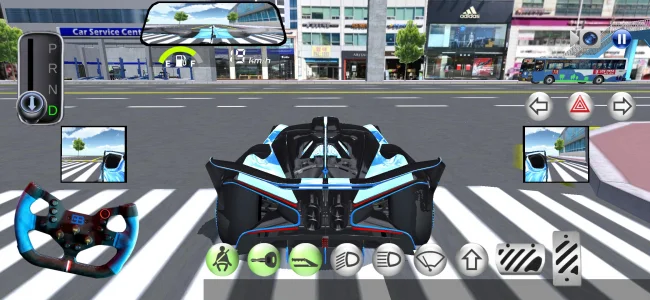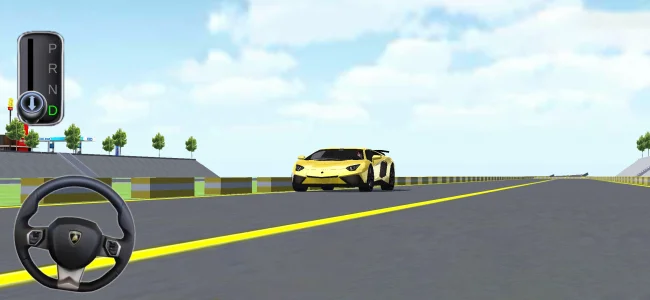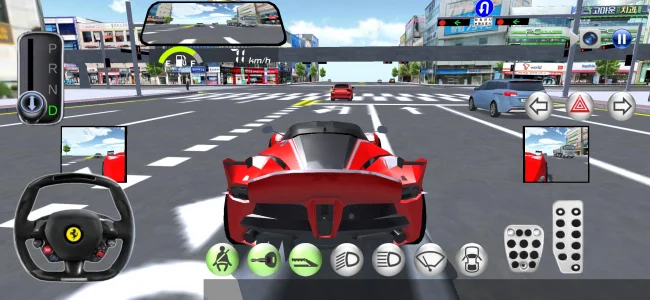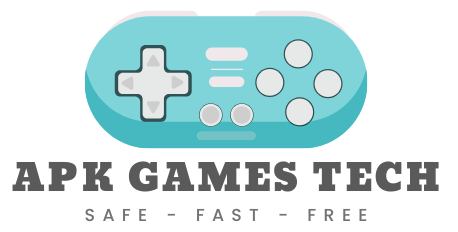Download 3D Driving Class MOD New Update
*3D Driving Class* is a mobile driving simulation game developed by Ho San Won, who is also published under the name John 3:16. The game’s core concept merges two distinct functions: a practical training tool designed to simulate the South Korean driver’s license test and an expansive, open-world sandbox that allows for free-roaming exploration. This hybrid model provides players with both structured, educational challenges and unrestricted driving entertainment.
Gameplay Gallery



3D Driving Class Overview
An Analytical Overview of 3D Driving Class
3D Driving Class represents a unique entry in the mobile gaming landscape, functioning as a sophisticated driving simulation that merges practical driver education with an expansive sandbox experience. Developed by an independent entity known as Ho San Won (or WonHoSan, Inc.) on the Apple App Store and "John 3:16" on the Google Play Store, this title originated as a training tool designed to align with the updated South Korean driver's license examination protocols of December 22, 2016. The application meticulously simulates official test procedures, including on-site skills tests and on-road driving exams with a realistic point-deduction system. Through a history of consistent and substantial updates, 3D Driving Class has transcended its initial purpose, evolving into a feature-rich, open-world driving game that has cultivated a global player base of simulation enthusiasts and casual gamers. The core proposition of this title is its dual identity. It serves as an effective, risk-free educational platform for learning vehicular control and traffic law adherence. Simultaneously, it operates as a free-roaming virtual environment, offering a diverse fleet of vehicles for exploration across a detailed and interactive world. This hybrid design allows the game to cater to multiple player motivations, bridging the gap between goal-oriented learning and unstructured entertainment. The development entity maintains a highly active presence, utilizing its official YouTube channel, "3D운전교실" (DriveSchool3D), to preview new content and engage with its community, signaling a responsive and player-focused development philosophy.Developer Profile and Publication Identity
A notable characteristic of 3D Driving Class is the developer's use of different names across major mobile ecosystems. The publisher is listed as "John 3:16" on the Google Play Store, a name referencing a well-known Christian Bible verse, suggesting a personal pseudonym. In contrast, the Apple App Store and third-party platforms identify the provider as "Ho San Won" and the corporate entity "WonHoSan, Inc." Cross-platform analysis confirms these names represent a single development source. Shared metadata, such as the official contact email ([email protected]) and a unified privacy policy URL, definitively link the two identities. This operational structure implies that the game is the product of a solo developer or a very small independent team. Such a scale explains the agile development cycle, characterized by frequent content updates that often respond directly to player feedback, but may also account for occasional unpolished elements or bugs due to limited quality assurance resources.Core Gameplay Architecture and Simulation Mechanics
The fundamental gameplay loop in 3D Driving Class is built upon a detailed and realistic vehicle operation simulation. Players engage with more than basic acceleration, braking, and steering; the system requires the management of ancillary controls such as turn signals, headlights, and windscreen wipers. A crucial element of the simulation is its strict enforcement of traffic laws, especially within its objective-based modes. The game world is populated with functional traffic signals and signs, and failure to comply with them results in point deductions that can lead to test failure. This system provides direct, consequential feedback that reinforces the game's educational value.Test-Oriented Scenarios and Progression
The initial foundation of the game is its suite of test modes, which meticulously replicate components of a formal driving examination. These scenarios challenge players with precision and control rather than speed, serving as a gateway to unlocking high-value in-game content. Successfully completing these challenges is a primary progression vector.- On-site Skills Test: This mode is set in a controlled driving school environment and focuses on low-speed technical maneuvers, including parallel parking and navigating tight cornering exercises.
- Road Driving Test: This scenario moves the examination into the open world, requiring the player to follow a specific route while obeying all traffic laws and safely interacting with AI vehicles. Passing this test grants the player a significant reward: an unlocked Lamborghini supercar.
- Course Test: A comprehensive, multi-stage assessment of driving skills, this mode includes challenges such as hill starts, emergency stops, acceleration courses, and right-angle parking. Completion of this rigorous course unlocks another coveted vehicle, a Ferrari.
Sandbox and Exploration Modes
For players seeking unconstrained freedom, 3D Driving Class offers several modes that remove the strictures of the examination scenarios. The "Free Ride" or "Free Driving" mode is the quintessential sandbox experience, allowing players to select any unlocked vehicle and explore the entire open-world map without objectives, time limits, or scoring. This mode highlights the game's evolution into a sprawling virtual playground. For performance-oriented driving, the "Race Track" mode provides a closed-circuit environment where players can test the top speeds and handling characteristics of their vehicles, particularly high-performance hypercars like the Lykan Hypersport, in a safe and dedicated setting.Digital Assets: Vehicle Fleet and World Design
The Vehicle Roster
A major attraction of 3D Driving Class is its extensive and varied collection of playable vehicles. The fleet begins with common models like the Chevrolet Sonic and Kia Carnival, but quickly expands to include luxury sedans and SUVs from premium marques such as Audi, Mercedes-Benz, and BMW. The most sought-after vehicles are the high-performance supercars and hypercars from iconic brands like Ferrari, Lamborghini, and Bugatti. The selection extends beyond automobiles to include scooters, motorcycles, buses, and various trucks, offering a broad range of driving experiences. New players are provided with a starter set of four vehicles—a BMW, a Honda, a Jeep, and a scooter—to begin their journey. Customization options include the ability to change a vehicle's body paint, and some cars feature functional elements like controllable convertible roofs and a performance-enhancing "sports mode".The Open-World Environment
The game's world is a dynamic and continually expanding map that serves as the backdrop for all gameplay. The developer's commitment to ongoing world-building is a key factor in long-term player retention. The map includes a diverse mix of locations, such as a small town, a complex city with AI traffic, a major ring road, highways with tunnels, a gas station, and a car wash. Key destinations provide unique gameplay opportunities and include a fully realized international airport, a bus terminal, a car dealership, a scenic beach, and a challenging mountain road. A particularly impressive feature is the comprehensive subway system, which features detailed station interiors that players can enter and ride. The world also contains interactive elements like a "car playground" with ramps and smashable blocks designed for physics-based entertainment. However, the simulation currently has notable limitations, including a persistent daytime-only setting and a complete absence of dynamic weather systems like rain or snow.Platform Ecosystem and Technical Specifications
3D Driving Class is accessible across a wide range of devices. The application is officially available for Android on the Google Play Store and for iOS on the Apple App Store, where it supports iPhone, iPad, and visionOS. While no native desktop client exists, the game can be operated on Windows PCs and Macs through the use of an Android emulator, with BlueStacks being a frequently recommended solution. System requirements vary by platform, with the Android version requiring Android 4.4 or higher and the iOS version demanding iOS 12.0 or later. For Android users obtaining the game via an APK file, it is critical to understand the file size structure. While the initial APK download may be small (e.g., ~72 MB), this file is a base installer. Upon the first launch, the application initiates a substantial additional data download, likely totaling 500-600 MB, to retrieve all necessary game assets. Therefore, users must ensure sufficient storage space (approximately 700 MB) and a stable Wi-Fi connection for the initial setup.Monetization Model and Player Economy
The game operates on a free-to-play (F2P) business model, supported entirely by in-app advertising. It is free to download and play, with revenue generated through ads presented during gameplay. A core component of this strategy is a rewarded video ad system. This value-exchange mechanism allows players to voluntarily watch an advertisement in exchange for in-game rewards. Community feedback indicates that this system is the primary method for unlocking premium vehicles, including highly desirable models like a Bugatti. Notably, the game does not appear to utilize traditional in-app purchases (IAPs), where players spend real money. This ad-only model makes player engagement a critical metric for the developer, directly fueling the continuous cycle of free content updates designed to maintain a large and active player base.An Analytical Guide to 3D Driving Class Gameplay
3D Driving Class offers a detailed vehicle simulation experience that combines educational objectives with open-world exploration. The game presents players with a hybrid model, merging structured driving examinations with a free-form sandbox environment. Player actions are centered on realistic vehicle operation, adherence to traffic laws, and mastery of diverse driving scenarios. The core gameplay loop requires players to manage vehicle controls with precision to achieve specific goals or to freely navigate a large, interactive world.
Core Driving Mechanics and Controls
The fundamental gameplay tasks players with operating vehicles in a manner that simulates real-world conditions. This system extends beyond basic acceleration, braking, and steering. Players must actively manage a suite of ancillary vehicle functions to succeed. The game interface provides controls for turn signals, headlights, and windscreen wipers. Proper use of these controls is essential for navigating the game’s challenges and is a key component of the simulation’s scoring system.
The Point Deduction System
A central mechanic, particularly within test-oriented modes, is the point deduction system. The game world is populated with traffic signs and signals that players must obey. This system enforces traffic laws by penalizing infractions. Actions such as exceeding the speed limit or failing to stop at a red light will cause the game to deduct points from the player’s score. This mechanic directly reinforces the game’s educational purpose, as accumulating too many deductions results in failure of an examination. It provides players with direct feedback on their driving performance and encourages safe, lawful operation of their vehicle.
Vehicle Operation and Customization
Players interact with a diverse roster of vehicles, ranging from scooters and sedans to high-performance supercars. The initial experience provides players with four starter vehicles: a BMW, a Honda, a Jeep, and a scooter. The game offers a degree of vehicle personalization. Players can change the body paint of their vehicles to any color. Some specific car models possess unique functional features that enhance the simulation. For example, certain cars feature controllable convertible roofs, while others include a “sports mode” which modifies their performance characteristics like acceleration and handling.
Comprehensive Analysis of Game Modes
3D Driving Class segments its gameplay into several distinct modes. Each mode presents a different set of objectives and rules, catering to players who seek either structured challenges or unrestricted freedom. The game effectively incentivizes engagement with all modes by gating high-value rewards behind the completion of its most difficult educational content.
Test-Focused Challenges
These modes represent the original foundation of the game and simulate components of the South Korean driver’s license examination. Success in these modes is based on precision and technical control rather than speed.
- On-site Skills Test: This mode confines the player to a controlled driving school course. The player must execute a series of precise, low-speed maneuvers. Key challenges include parallel parking and navigating tight cornering sections without error.
- Road Driving Test: This mode places the examination within the game’s open world. The player follows a predetermined route through city traffic. The objective requires the player to obey all traffic laws, manage intersections correctly, and interact safely with AI vehicles to complete the course with minimal point deductions.
- Course Test: This is a multifaceted assessment of driving skill that unfolds across several distinct segments. The player must successfully complete challenges that include Car Device Control, a Hill Start, Left and Right Turns, Intersection Navigation, an Acceleration Course, an Emergency Stop maneuver, and Right-Angle Parking.
Sandbox and Exploration Modes
These modes remove the strict objectives and point systems, providing players with complete freedom to explore the game world and test vehicle performance.
- Free Ride: This mode is the game’s ultimate sandbox experience. Players can select any unlocked vehicle and drive throughout the entire map without time limits or prescribed goals. This mode allows players to discover new locations and create their own driving scenarios.
- Race Track: This mode provides a dedicated, closed-circuit track for high-speed driving. Players can test the performance limits of their vehicles in a safe environment. This space allows players to master high-speed cornering and attempt to achieve personal best lap times.
Player Progression and Vehicle Unlocks
Player progression in 3D Driving Class is directly tied to the successful completion of its most challenging modes. The game implements a reward structure that grants access to highly desirable vehicles as a result of skill mastery. This system creates a clear path for players to follow, motivating them to engage with the educational content to unlock powerful assets for use in the sandbox modes.
Completing the Road Driving Test serves as a significant player milestone. The game rewards a successful pass of this rigorous on-road exam by unlocking a Lamborghini supercar for the player’s garage. Similarly, the successful completion of the multi-stage Course Test provides another high-value reward. Players who master its diverse challenges unlock a Ferrari supercar. This design ensures that players of all types experience the game’s core learning mechanics to gain access to its most exciting content.
Exploring the Open-World Environment
The game’s open world is a large and dynamic space that serves as the setting for all gameplay modes. The developer consistently expands this world through updates, adding new locations and features that provide players with fresh areas to explore.
Key Locations and Features
The map contains a diverse mixture of environments and interactive destinations. Urban areas range from a small town to a complex city with a realistic AI traffic system. This infrastructure is connected by a major ring road and highways with tunnels. Players can interact with service locations like a gas station and a car wash. The world also features numerous unique points of interest.
- Major Destinations: The map includes a fully realized international airport with unique airport-specific vehicles, a bus terminal, and a car dealership. A detailed subway system allows players to enter stations and ride the trains.
- Recreational Areas: Players can visit a scenic beach, navigate a challenging mountain road, or experiment in a dedicated “car playground.” This playground area contains ramps and smashable blocks, allowing players to test vehicle physics in a fun environment.
- World Limitations: The simulation currently has some environmental limitations. The game world exists only in a persistent daytime setting, as it does not feature a day-night cycle. Furthermore, the simulation lacks dynamic weather conditions, meaning environmental effects like rain or snow are not present.
